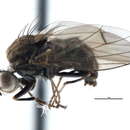Comprehensive Description
(
Inglês
)
fornecido por Smithsonian Contributions to Zoology
Notiphila (Notiphila) solita Walker
Notiphila solita Walker, 1853:406.
Notiphila vittata Loew, 1862:136.—Mathis, 1977b:537.
Notiphila (Agrolimna) solita.—Wirth, 1965:748.
TYPE-MATERIAL.—Lectotype male (herein designated): “68·4/US (United States)/solita/United States, W. W. Saunders. B.M. 1868-4/LECTOTYPE Notiphila solita Walker by W. N. Mathis (red).” The lectotype is in the British Museum (Natural History). The holotype female of the junior synonym bears the following label data: “Dista-Columb(ia). (green)/Loew Coll./vittat. /Type 11127 (red)/Notiphila vittata Lw. det W. Wirth ’61.” This specimen is deposited in the Museum of Comparative Zoology, Harvard University, type number 11127.
DIAGNOSIS.—Specimens of this species very closely resemble those of N. pauroura and have often been confused with the latter. Like specimens of N. pauroura, the sides of the scutellum are blackish brown when viewed from a posteroblique angle. Specimens of N. solita may be distinguished from those of N. pauroura by the following combination of characters: Median stripe on mesonotum not as evident, in most specimens it is considerably weaker than lateral, mesonotal markings, usually the stripe is also weakly produced posteriorly; fifth abdominal tergum of N. solita males also as long as wide. Male genitalia are very distinct: Epandrium broadly produced toward middle but markedly tapering toward both ends; venter of epanrium projecting forward, terminating as a broadly U-shaped process (from a lateral view this process projects upward at an obtuse angle); basiphallus of aedeagus subelliptical; lobe of hypandrial process as long as base.
DESCRIPTION.—Moderately small to moderately large shore flies, length 2.81 to 4.25 mm; olive gray to light tannish gray in coloration with brown markings.
Head: Head ratio 1:0.71; postfrons ratio 1:0.70; frons with extreme lateral margins concolorous with face; median triangle and surrounding area of frons nearly concolorous, brownish gray, pollinose, although the triangular area slightly lighter. Para-vertical bristle much large than postocellar setae, approximately twice their size; often without proclinate, fronto-orbital setae, if present, very small. First and second antennal segments dark brown except for anterodorsal surface of second, which is yellowish; third antennal segment mostly yellowish orange, darker apically and dorsally; arista with 10–12 dorsal branches. Face light grayish yellow; prefrons ratio 1:0.61; facial setae with 3–4 setae that are subequal to postocellar setae. Eye ratio 1:0.75; eye-to-cheek ratio 1:0.14. Gena very narrow, concolorous with face anteriorly, becoming gray posteriorly genal bristle subequal to paravertical bristle. Maxillary palpus yellow.
Thorax: Mesonotum darker than pleural areas; median stripe of mesonotum weakly developed, especially posteriorly; mesonotum with vittate markings extending from anterior to presutural bristle, posterior through anterior supra-alar bristle area, across dorsum of notopleuron weakly developed. Lateral margin of scutellum appearing blackish brown as viewed from posterior angle. Mesopleuron with distinct vittate markings toward dorsal surface, extending from mesospiracle to larger bristles along posterior margin and along the posteroventral edge. Femora unicolorous, grayish black, apically pale; tibiae various, front tibia mostly dark, hind tibia only darkened preapical ring. All tarsi pale, yellow. Setal fascicle of hind basitarsus with 3 dark setae. Wing ratio 1:0.41; costal vein ratio 1:0.44; M1+2 vein ratio 1:0.67.
Abdomen: Abdomen ratio of males 1:0.50; length of fourth tergum to fifth tergum ratio of males 1:1.40; fifth tergum ratio of males 1:0.84. Terga with maculation pattern as in Figures 99–100. Male terminalia as in diagnosis and in Figures 101–103.
SPECIMENS EXAMINED (111).—CANADA: MANITOBA: International Peace Gardens-Turtle Mountain Forest Reserve (CNC). ONTARIO: Grand Bend (CNC); Kingston (ANSP); Marmora (CNC); Ottawa (CNC); Point Pelee (CNC). QUEBEC: Abbotsford (CNC); Fairy Lake (CNC); Kazabazua (CNC); Norway Bay (CNC). UNITED STATES: FLORIDA: Alachua Co., Gainesville (CNC); Dade Co., near Mahogany-Everglades National Park (FSCA), Highlands Hammock State Park (FSCA), Flamingo to Mahogany—Hammock in Everglades National Park (FSCA); De Soto Co., Fort Ogden (CNC); Duval Co., Jacksonville (ANSP). ILLINOIS: Cook Co., River Forest (USNM); Lake Co., Waukegan (ANSP, INHS); McHenry Co., Fox River Grove (USNM), McHenry (USNM); Winnebago Co., Rockford (AMNH). INDIANA: Tippecanoe Co., LaFayette (USNM). IOWA: Dickinson Co., Iowa Lakeside Laboratory (ISU); Hamilton Co., Goose Lake (USNM). MARYLAND: Calvert Co., Chesapeake Beach (USNM); Charles Co., Popes Creek (ANSP, MCZ). MICHIGAN: Manistee Co., Pierport (MSU); Monroe Co., Monroe (ANSP, USNM); Shiawassee Co., Owosso (USNM); Wayne Co., Detroit (USNM); Grosse Ile (USNM). NEBRASKA: Cherry Co., Snake Falls (USNM). NEW JERSEY: Forest Hill (ANSP); Burlington Co., Riverton (MCZ); Essex Co., Newark (AMNH, ANSP, FSCA), W Orange (USNM); Glaucester Co., Westville (MCZ). OHIO: Erie Co., Sandusky (ANSP, OSU); Franklin Co., (OHSU); Fulton Co., Wauseon (ANSP, OHSU); Portage Co., 1.6 km E Kent (KSU), 4.8 km E Kent (WNM), 7.2 km E Kent (KSU), 9.7 km S Kent (KSU), Mogodore Reserve (KSU); Wayne Co., 0.8 km S Rittman (KSU, USNM). PENNSYLVANIA: Crawford Co., Hartstown (USNM); Philadelphia Co., Philadelphia (MCZ). TEXAS: Galveston Co., Dickinson (ANSP). VIRGINIA: Independent City, Alexandria (ANSP, USNM).
GEOGRAPHIC DISTRIBUTION (Figure 104).—Notiphila solita occurs throughout eastern North America, although collecting records from the Southeast are few. Collection dates are from 9 April to 14 October.
DISTRIBUTION.—The Nearctic species of this group occur primarily below 40° north latitude but extend well into the Neotropics.
- citação bibliográfica
- Mathis, Wayne Neilsen. 1979. "Studies of Notiphilinae (Diptera: Ephydridae), I: Revision of the Neartic Species of Notiphila Fallen, Excluding the Caudata Group." Smithsonian Contributions to Zoology. 1-111. https://doi.org/10.5479/si.00810282.287

